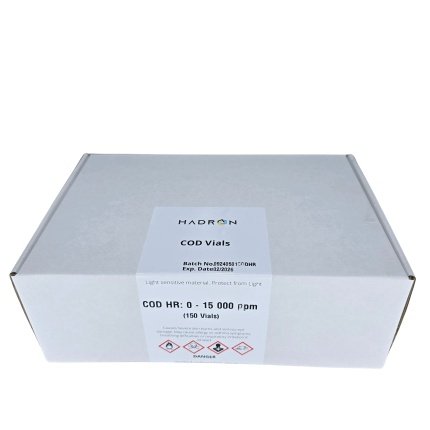

Standard Shipment
3 - 5 working days
IMPORTS
6 - 8 Weeks

R3,985.00 – R5,813.00Each
Medium range Chemical Oxygen Demand (COD) vials are essential laboratory tools for accurately measuring organic pollutants in water samples.
| Weight | N/A |
|---|
Fermentum scelerisque hendrerit parturient nullam enim lobortis litora parturient dictumst.
Potenti a quisque tincidunt venenatis adipiscing parturient fermentum nisl tincidunt amentu.
Scelerisque conubia lobortis a condimentum ad eleifend dui integer maecenas habitant nostra.
| Specification | Chair | Armchair | Sofas |
| Height | 37" | 42" | 42" |
| Width | 26.5" | 32.5" | 142" |
| Depth | 19.5" | 22.5" | 24.5" |
| Assembly Required | No | No | Yes |
| Packaging Type | Box | Box | Box |
| Package Weight | 55 lbs. | 64 lbs. | 180 lbs. |
| Packaging Dimensions | 27" x 26" x 39" | 45" x 35" x 24" | 46" x 142" x 25" |
Medium range Chemical Oxygen Demand (COD) vials are specialized laboratory containers designed for the precise measurement of organic matter in water samples. These vials serve a crucial role in water quality assessment, offering a reliable method to gauge the concentration of organic pollutants, which can significantly impact environmental health and compliance with regulatory standards.
The primary purpose of COD measurement is to determine the amount of oxygen required to chemically oxidize organic substances present in a water sample. This is essential in assessing the pollution levels in wastewater, surface water, and drinking water sources. The higher the COD value, the more organic matter is present, indicating higher levels of contamination. Medium range COD vials typically cater to samples that exhibit moderate to high concentrations of organic materials, commonly occupying a measurable range of 10 to 1500 mg/L.
In terms of chemistry, the COD test primarily relies on a strong oxidizing agent, usually potassium dichromate, in the presence of sulfuric acid; this facilitates the oxidation of the organic compounds in the sample. The resultant data is critical for industries such as wastewater treatment, environmental monitoring, and industrial processes, where tracking organic loads is necessary for operational efficiency and regulatory adherence.
Typically, medium range COD vials are constructed to withstand harsh chemical environments and maintain sample integrity. Features include sealed caps to prevent contamination and evaporation, as well as marked volume indicators for accuracy. Selecting the appropriate vial is vital for achieving reliable and reproducible results, ensuring that water quality assessment remains accurate and consistent.
Overall, the utilization of COD vials provides essential data for researchers, environmental scientists, and industrial professionals. Their capacity to accurately measure organic pollutants aids in environmental protection and management, highlighting their significance in various applications.
Medium range Chemical Oxygen Demand (COD) vials play a crucial role in various sectors, primarily due to their ability to accurately measure the organic pollutants in water samples. One of the primary applications of these vials is in municipal wastewater treatment. In this context, they are utilized to monitor the effectiveness of treatment processes, ensuring that treated water meets specific regulatory standards before being released back into waterways. By providing precise COD measurements, these vials assist wastewater treatment facilities in optimizing treatment protocols and enhancing overall process efficiency.
Another significant application of COD vials is in industrial effluent monitoring. Industries producing high volumes of wastewater, such as manufacturing, food processing, and chemical production, must regularly evaluate their effluents’ COD levels. The use of these vials allows industries to quickly assess their wastewater quality, identifying potential environmental risks and ensuring compliance with legislative requirements. This proactive approach aids in minimizing environmental impact and promoting sustainable operational practices.
In addition to their application in treatment facilities and industrial settings, COD vials are extensively used in environmental research. Researchers rely on these vials to study the impact of pollutants on aquatic ecosystems. By measuring COD levels in various water bodies, scientists can gather critical data that informs conservation strategies and policy-making. Furthermore, the ease of use and reliability of these vials make them ideal for field studies, allowing researchers to obtain accurate results under varying conditions.
The advantages of COD vials extend beyond their applications. They are user-friendly, providing quick and straightforward testing procedures, which save time and reduce the risk of human error. Their reliability and accuracy significantly enhance the quality of water testing, making them an essential tool for ensuring compliance with environmental regulations and safeguarding water resources.
COD MR SDS


3 - 5 working days
6 - 8 Weeks
No account yet?
Create an AccountWe use cookies to provide you with the best possible web experience. Clearing cookies may limit your banking functionality. Some cookies are strictly necessary for our website to function properly and cannot be switched off. To maintain these settings view "Cookie Preferences" in the menu